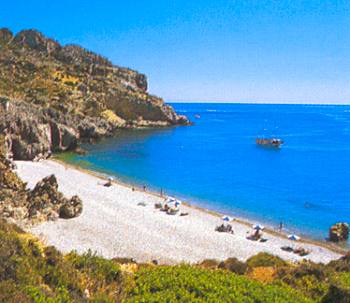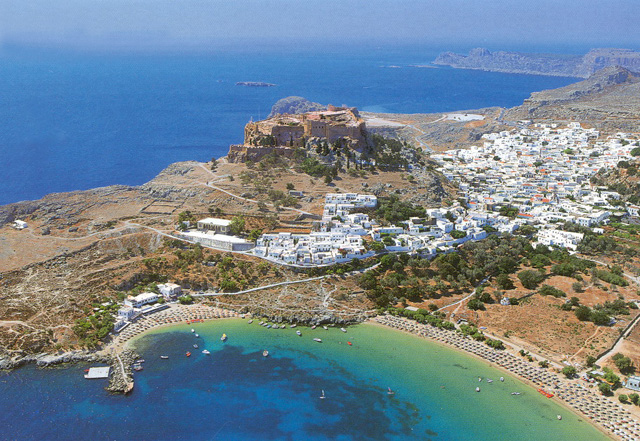



 ACROPOLIS OF LINDOS Lindos is its rock
ACROPOLIS OF LINDOS Lindos is its rockThis rock, which rises to 116 m. forms the finishing touch to the landscape of Lindos, standing dry and imposing in its bareness and surrounded on all sides by the sea, so that Lindos ,may rejoice in the ocean, in the words of a hellenistic epigram. Lindos does not seem to have been particularly important in the earlier periods, though sporadic finds of the Neolithic period and the Bronze Age have been discovered on the acropolis. According to legend, the foundation of the sanctuary of Athena Lindia goes back to the Mycenaean period, and Mycenaean finds have been yielded by cemeteries in the broader area of Lindos. The Archaic period (7th-6th c BC) was a golden age for Lindos, which played a leading role in the Greek colonisation movement, its most important foundation being Gela in Sicily. The 6th c BC was dominated by the figure of a moderate tyrant, Kleoboulos who ruled Lindos for many years, and was Included amongst the �seven sages� of the ancient world.
During his rule, the Archaic temple of Athena was built on the site of an earlier structure, and the acropolis received its first monumental form. The Persian advance and later the merger of the three old cities into the new city of Rodos (408 BC) led to a diminution in the importance of Lindos as a political and economic power.
It nevertheless continue to be an important centre, focused on the famous sanctuary of Athena, which received its final monumental form in the Hellenistic period and became the leading sanctuary on the island. The acropolis was used as a fortress in antiquity, as well as In Byzantine times, in the period of the Knights of St. John, and in that of Ottoman rule.
Today, the ascent to the acropolis is still by the same steep road as in antiquity. After the first outer entrance to the medieval fortress, and before beginning to climb the large stairway that leads up to the Administrative Building of the Knights, we encounter two important monuments on our left a semicircular Hellenistic exedra, and, next to it, a depiction of the prow of an ancient ship carved in relief in the rock, which formed the base of a statue of Agesandros son of Milkion, the work of the sculptor Pythokritos in the early 2nd c. BC The fortification of Lindos by the Knights goes back to the 14th-15th c AD.
Passing through the ground - floor of the Knights Administrative Build Building, we emerge into a large square, which occupies the lowest level of the acropolis and was full of votive offerings in ancient times. A row of vaulted structures, built in the l st c. BC, stood on either side of a stairway leading up to the level of the large Hellenistic stoa, built ca. 200 BC. The large stairway behind the stoa leads up to the highest level where are to be found the Propylaia and the temple of Athena, which formed the main sacred precinct.The temple was completely isolated from the outside world by a wall with five entrances. In front of and behind it were stoas with rooms. The inner stoa flanked a courtyard in front of the temple, in which there was probably an altar. The temple, which measures about 22x8 m is a Doric, amphiprostyle tetrastyle structure. It was constructed in the 4th c. BC or in the early Hellenistic period on the site of Kleoboulos� temple, which had burned down in 392 BC. It stands at the highest point of the rock and was the culmination of the stepped vista offered by the stoa and the Propylaia to anyone ascending to the acropolis.
From the highest point of the acropolis can be seen the lower city, in which the most important monuments still visible are the theatre, the Tetrastoon and the Archokrateion at Kambana, a monumental tomb of an important Lindian family. The Byzantine church of the Panayia is also in the lower city. it was built It In the 15th c. and decorated with wall-paint paintings in the 17th and 18th c. The traditional settlement of Lindos is in a very good state of preservation. A large number of archontika (mansions) survive, the most Important of them from the 17th c., indicating that Lindos was a flourishing naval power in the early period of Turkish rule, as indeed throughout its entire history.
The Lindos Castle is found on the top of a 116m rock and serves as an entrance point to the Acropolis and the temple of Athena and once was used as the administrative building of the Knights. Today, the ascent to the acropolis Is still by the same steep road as in antiquity. After the first outer entrance to the medieval fortress, and before beginning to climb the large stairway that leads up to the Administrative Building of the Knights, we encounter two important monuments on our left a semicircular Hellenistic exedra, and, next to it, a depiction of the prow of an ancient ship carved in relief in the rock, which formed the base of a statue of Agesandros son of Milkion, the work of the sculptor Pythokritos in the early 2nd c. BC
The fortification of Lindos by the Knights goes back to the 14th-15th c AD. Passing through the ground - floor of the Knights Administrative Build Building, we emerge into a large square, which occupies the lowest level of the acropolis and was full of votive offerings in ancient times.
http://www.faliraki-info.com/lindos/history.htm



No comments:
Post a Comment